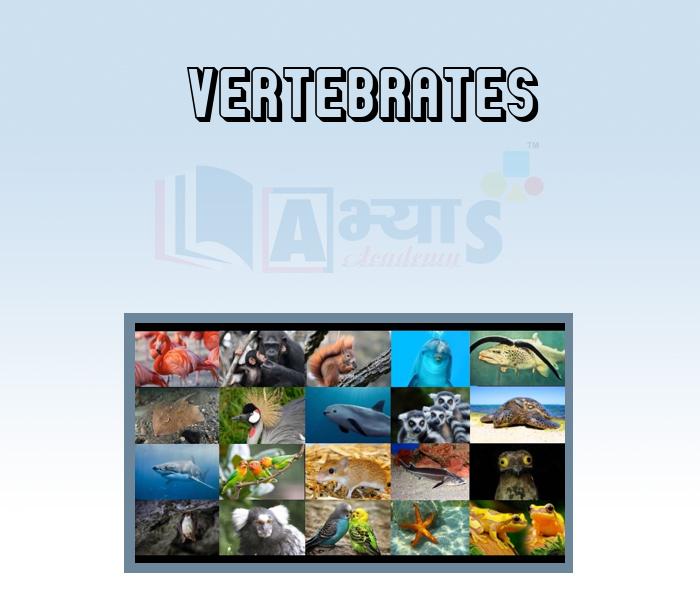Vertebrates










Vertebrates
Animal Species:
Vertebrate: Vertebrates, animals with a backbone or spinal column, are made of interlocking units called vertebrae. This strong but flexible structure supports the body and anchors the limbs, and it also protects the nerves of the spinal cord. Vertebrates include fish, amphibians, and reptiles, as well as birds and mammals. In all vertebrates, the spinal column forms part of a complete internal skeleton. Unlike the hard external skeleton covering an insect, which is periodically shed as the insect grows, a vertebrate's internal skeleton can grow gradually along with the rest of the body.
There are several reasons why vertebrates are so successful and so noticeable. One has to do with their size. Invertebrates-that is, animals without backbones, such as worms, shellfish, and insects-tend to be small and slow moving. This is because they lack effective ways to support a large body and the muscles needed to power it. Vertebrates, on the other hand, have evolved a much more versatile support system. Their skeletons can be adapted for use in many different ways and work just as well in an animal weighing 4 tons as in one weighing 113 g (4 oz). As a result, vertebrates have been able to develop bigger, faster bodies than invertebrates.
Vertebrates also have highly developed nervous systems. With the help of specialised nerve fibres, they can react very quickly to changes in their surroundings, giving them a competitive edge.
Characteristics: In nearly all vertebrates, bone gives the skeleton its strength. Bone is a living tissue composed of hard mineral salts produced by specialised cells. A vertebrate's spinal column is held together by strong ligaments, but the faces of adjoining vertebrae are separated by elastic pads called intervertebral disks. Humans have 33 vertebrae, making us fairly flexible, and some snakes have more than 400, enabling them to shape their bodies into coils.
Besides the backbone, vertebrates share many other physical features. Their bodies are more or less bilaterally symmetrical (divisible into two equal halves), with sense organs concentrated in the head. Most vertebrates have jaws, and their brains are usually protected by a bony case called the cranium. Most also have limbs, but the shapes and uses of vertebrate limbs vary enormously. Fish typically have several paired fins and a large finned tail, but all other vertebrates either have four limbs or are descended from ancestors that had four.
Four limbed animals, known as tetra pods, use their limbs to swim walk, run, and fly. Nearly all vertebrates breed by sexual reproduction, either laying eggs or giving birth to live young. The few exceptions to this rule include animals such as North American whiptail lizards, which can breed without mating in a process known as parthenogenesis. In several species of these lizards, males have never been found.
Students / Parents Reviews [10]
Abhyas is a complete education Institute. Here extreme care is taken by teacher with the help of regular exam. Extra classes also conducted by the institute, if the student is weak.

Om Umang
10thA marvelous experience with Abhyas. I am glad to share that my ward has achieved more than enough at the Ambala ABHYAS centre. Years have passed on and more and more he has gained. May the centre flourish and develop day by day by the grace of God.

Archit Segal
7thIt was a good experience with Abhyas Academy. I even faced problems in starting but slowly and steadily overcomed. Especially reasoning classes helped me a lot.

Cheshta
10thMy experience with Abhyas is very good. I have learnt many things here like vedic maths and reasoning also. Teachers here first take our doubts and then there are assignments to verify our weak points.

Shivam Rana
7thI have spent a wonderful time in Abhyas academy. It has made my reasoning more apt, English more stronger and Maths an interesting subject for me. It has given me a habbit of self studying

Yatharthi Sharma
10thIt was good as the experience because as we had come here we had been improved in a such envirnment created here.Extra is taught which is beneficial for future.

Eshan Arora
8thIt has a great methodology. Students here can get analysis to their test quickly.We can learn easily through PPTs and the testing methods are good. We know that where we have to practice

Barkha Arora
10thOne of the best institutes to develope a child interest in studies.Provides SST and English knowledge also unlike other institutes. Teachers are co operative and friendly online tests andPPT develope practical knowledge also.

Aman Kumar Shrivastava
10thMy experience was very good with Abhyas academy. I am studying here from 6th class and I am satisfied by its results in my life. I improved a lot here ahead of school syllabus.

Ayan Ghosh
8thMy experience with Abhyas academy is very good. I did not think that my every subject coming here will be so strong. The main thing is that the online tests had made me learn here more things.
